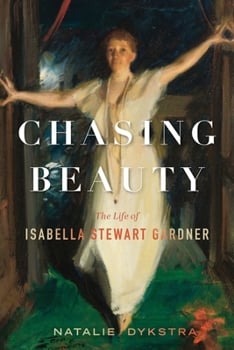10 Fascinating Facts About Isabella Stewart Gardner
By Hannah Wright | On February 15, 2024 | Updated March 25, 2024 | Comments (0)

Chasing Beauty: The Life of Isabella Stewart Gardner (Mariner Books, March 2024), award–winning author Natalie Dystra delivers the definitive biographical portrait of the ambitious and innovative—and until now misunderstood—woman behind one of America’s most important art collections.
With access to all archival holdings at the Isabella Stewart Garner Museum—including thousands of digitized and newly accessible letters and other unpublished records—as well as original sources in Paris, Venice, and more. Dykstra brings Isabella to life as never before.
An incredible achievement of storytelling and scholarship, Chasing Beauty illuminates the fascinating ways the museum and its holding can be seen as a kind of living memoir—how Isabella “put herself on display… her taste, her passions, her sorrow, her nerve, her capacious curiously, relationships,” Dykstra reveals.
Isabella’s meticulous curation of the exhibits became her voice, enabling her story to be told through the objects she cherished most.
Enjoy the following fascinating facts about the life of the American art collector Isabella Stewart Gardner, excerpted from material provided by Mariner Books, the publisher of Chasing Beauty by Natalie Dykstra.
. . . . . . . . . .

Isabella Stewart Gardner in 1888
. . . . . . . . . .
Isabella married Boston Brahmin Jack Gardner at age 19
Before her marriage to Jack, her childhood was spent in New York and Paris where she studied art, music, dance, French, and Italian. Provided with a picture of her childhood, one begins to understand why the spirted, original, sophisticated young Isabella (known then as Belle) was not later embraced by Boston society.
She had a competitive, simpatico relationship with John Singer Sargent
Together Gardner and Sargent—considered the most successful portrait painter of his time—constructed quite the scandal surrounding his iconic 1888 portrait. Jack Gardner said to his wife at the time. “It looks like hell, but it looks like you.”
Isabella was an entrepreneur
Much attention has been devoted to how Isabella used glamour and even scandal to assert her cultural position. Chasing Beauty shows how the public performance was in many ways a screen for her more serious, radical work of competing as a connoisseur/collector in order to create her sui generis museum.
. . . . . . . . . .

“Mrs. Gardner in White” by John Singer Sargent (1922)
. . . . . . . . . .
She had a fraught but essential relationship with Bernard Berenson
Jack Gardner came to mistrust Berenson, the brilliant historian of the Italian Renaissance, for his lack of transparency in business matters. Isabella, however, knew how to parry with Berenson but not keep him close, as she relied on him to secure her greatest art purchases.
Jack Gardner was a loving and supportive husband
Jack showcased Isabella’s moves, supported her ambitions—and forgave her after one notable affair of the heart. Jack’s parents, typically Bostonian in most ways, were fiercely loyal to her as well, which bolstered her nerve. They were married for 38 years.
Isabella was friends with Henry James
Isabella’s friendship with Henry James textured one his novels – elusive and complicated; but the friends understood each other. James compared her to a shining jewel in a magnificent setting and finding in her character inspiration for his fiction.
Isabella was a spiritual woman
Isabella turned to the spiritual as a means of healing. Later in life she paid attention to social causes, particularly those helping women, children, and others in need— she gave substantial funds, for example, towards the building of an African American Episcopal church on Beacon Hill.
. . . . . . . . . .

Isabella Stewart Gardner Museum Courtyard Boston, MA
. . . . . . . . . .
The museum was performance art for Isabella
It acted as a kind of “Isabellaland,” as a memoir using objects instead of words. She juxtaposed the life and movement of the dancer in Sargent’s El Jaleo with grief and memory at the other side of the Spanish Gallery, in the small chapel, a memorial to her only child who died before the age of two.
Radically, she placed Titian’s great Europa above a framed section of satin taken from one of her own Charles Fredrick Worth-designed gowns. She also filled the Raphael Room with objects that show or fill a woman’s life: paintings depicting—her collections most frequent motif—Madonna and Child; cassoni filled with luxurious fabrics; fine old Italian furniture arranged as if for a parry.
Jewlery played an extraordinary in Isabella’s life
She used a language of pearls, borrowed from aristocratic portraits and earlier eras, to make her own statement. In much of the portraiture done of her she can be seen wearing a string of pearls.
Isabella was a “late bloomer”
Isabella’s later decades are often skimmed over, despite having compelling and moving accomplishments as she aged. Isabella opened her museum in 1903, as she was about to turn sixty-three. She became more expansive and curious as she got older.
She found family-like relationships with artists and writers, designers and activists. Her relationship with in her sixties with Okakura Kakuzō, Japanese art expert living in Boston for a time, was especially intense and remarkable.
. . . . . . . . . .

Chasing Beauty is available wherever books are sold
. . . . . . . . . .
About Natalie Dystra, Author of Chasing Beauty
Natalie Dykstra is the author of Clover Adams: A Gilded and Heartbreaking Life. Her work on Isabella Stewart Gardner has won a Public Scholars Award from the National Endowment for the Humanities and an inaugural Robert and Ina Caro Research/Travel Fellowship sponsored by the Biographers International Organization (BIO). Dykstra, emerita professor of English at Hope College in Michigan, lives with her husband in Waltham, MA.
Leave a Reply